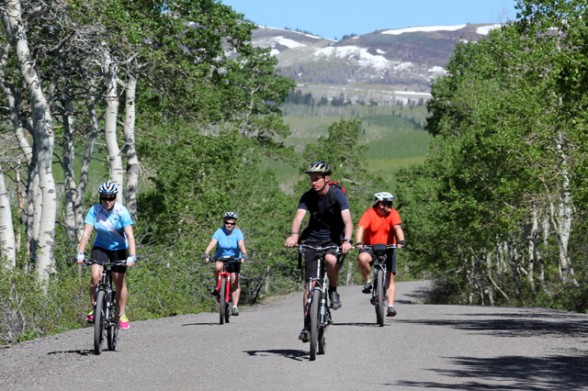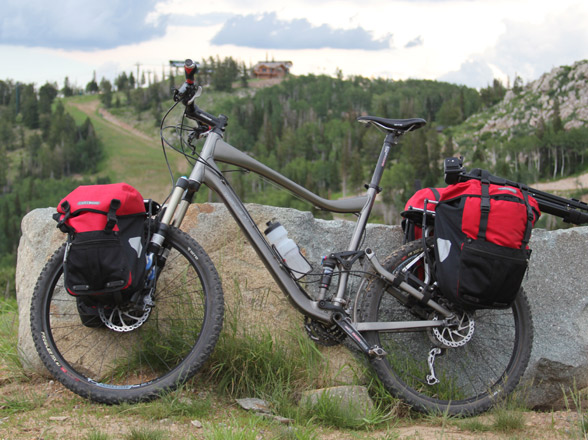The Different Types Of Bicycle Touring
In addition to the three main types of bicycle tours discussed in this article, there are a number of different sub-types and alternative names for bicycle touring. This article gives a brief overview of the different types of bicycle tours available to you as a guided, self-guided or self-supported bicycle tourist.
Day Touring
Day touring isn’t really a type of bicycle tour at all, but actually just a single-day bike ride. There are two main types of day tours you might encounter:
Day touring can consist of simply jumping on your bicycle and going for a ride that stretches for a span of 24-hours or less. This might just be a long bike ride near your home, a road trip where you travel by car and then spend part of your time cycling, or it could involve renting a bicycle in a foreign city/country and taking a spin around the local area.

The other type of long day trip you might encounter is a bicycle tour conducted by an organization which brings cyclists together in a single location and these people ride their bikes for a relatively long distance in a single day. Typical rides of this type can range from 10 – 100+ miles/kilometers in a 24-hour time span and are often times organized as an event that you have to pay in order to be a part of.
Day touring can be classified as a guided, self-guided or self-supported bicycle tour. While traditional bicycle touring is typically an overnight activity, these single-day bike rides and organized cycling events are often times called “bicycle tours.”
S24O or Overnight Touring
The S24O (or Sub-24-Hour-Overnight (also referred to as Overnight Touring)) is a type of bicycle tour in which you spend one day riding your bicycle to a nearby destination (a friend’s house, campground, hotel, etc.) where you rest for the night and then spend the following day returning by bike to your home or starting location.
This is slightly different than day touring because the S24O consists of two days of cycling and one overnight stay, whereas a day tour consists of only one day of cycling and no overnight rest stops. S24O bike tours are typically self-supported.
Credit Card Touring
Credit card touring is when you travel by bike and pack almost nothing but the clothes on your back and a credit card (or cash) to buy things along the way. Instead of carrying a tent and sleeping bag, you pay to sleep in a hotel each night. Instead of cooking your own food, you buy food along the way. Credit card tours are typically (but not always) less than a week in length and are usually not supported by a touring company.
Light Touring
Light touring refers to a type of bike tour in which you carry just a small load on your bicycle – usually in two panniers mounted on the rear rack of your bike. While light touring can technically be guided, self-guided or self-supported, light touring differs from fully-loaded bicycle touring (which we will discuss in just a moment) because a loaded bicycle tourist will be carrying his or her belongings in four total panniers (two on the front and two on the back), while a light tourist will only have two panniers (usually mounted on the rear rack of his or her bicycle).

Ultra-lite Touring
Ultra-lite bicycle touring is a name that can be attached to almost any type of bicycle tour. Ultra-lite touring simply refers to a means of bike travel in which measures are taken to drastically reduce the size and weight of food, clothing and equipment so as to increase speed and the overall distance covered. Ultra-lite touring is typically, but not always, self-supported.
Supported Touring
A supported bicycle tour is any type of bike tour where you receive assistance from either a private individual, tour guide or touring company in carrying your gear and/or navigating along your route.
If you sign up to conduct a guided bike tour with a professional touring company, you are signing up to participate in a supported tour. If you choose to participate in a self-guided bicycle tour, you may or may not be participating in a supported bike tour – depending on whether or not the touring company you’ve booked with will be transporting you and/or your belongings from one destination to the next.
Supported touring differs from guided bicycle touring because a guided tour is always conducted with either a professional guide or a touring company, whereas a supported tour may be (but is not always) supported by a friend or loved one driving alongside you in a chase vehicle.

Guided, Self-Supported Touring
A guided, self-supported bicycle tour is a type of tour where you are required to carry everything you need to survive on your bicycle (food, clothing, bike tools, etc.), but a guide from a touring company leads you along a specific route. With these types of tours, you typically ride with a small group of people and are then escorted on a daily basis by an experienced bicycle touring guide.
Guided, self-supported bicycle touring is a combination of guided and self-supported bicycle touring. There is usually no support vehicle on a guided, self-supported bike tour.
Bikepacking / Cyclocamping
Bikepacking and/or cyclocamping refer to a means of bicycle travel in which you cycle mainly off-road and carry a minimalistic amount of food, gear and clothing. Because of the rough terrain involved with bikepacking/cyclocamping, mountain bikes and/or off-road friendly touring bicycles are commonly used.
While bikepacking and cyclocamping refer pretty much to the same thing, the major difference between the two activities is that bikepacking is more about the bike riding experience, while cyclocamping is more about getting into nature on your bike and finding a pleasant place to camp. One puts more emphasis on the cycling and the other puts more emphasis on the camping. Bikepacking/cyclocamping is typically a self-supported endeavor.

Mixed-Terrain Touring
Mixed-terrain touring is a name that can be applied to almost any type of bicycle touring. While most bicycle tours are conducted on paved roads or bicycle paths, a mixed-terrain bicycle tour might require you to cycle across dirt roads and/or trails, snow covered passes, ice-laden tundra, or anything in between. Mixed-terrain touring can be guided, self-guided or self-supported.
Expedition Touring
Expedition Touring is sub-sect of self-supported bicycle touring. The main difference between the two, however, is that expedition touring requires you to travel through remote areas, developing nations, and/or places outside of traditional bicycle touring roads and routes, while traditional self-supported bicycle touring is usually conducted on paved roads and in civilized countries.
Loaded Or Fully-Loaded Touring
Loaded bicycle touring (also called fully-loaded bicycle touring) refers to any bicycle tour where you are carrying four or more panniers on your bike. A loaded touring bicycle usually consists of two large panniers on the rear rack and two smaller panniers on the front. A loaded bicycle might also be equipped with a handlebar bag, rack pack(s), and/or additional gear on it’s front or rear racks.
If you choose to carry only two panniers of the rear rack of your bicycle, you are conducting a light bicycle tour. But if you have four panniers on your bicycle, you are riding fully-loaded.
Traditional Bicycle Touring
When you hear someone talking about traditional bicycle touring, they are generally referring to a fully-loaded, self-supported bicycle tour on paved roads using a road touring bicycle.
Traditional bicycle touring is the type of bicycle tour most self-supported bike tourists will participate in when they first start out. These individuals may eventually transition into off-road touring or other, more challenging types of bicycle tours, but most self-supported travelers start out as traditional bicycle tourists.
Bicycle Travel
While bicycle travel may refer to any of the various types of bicycle touring, it is generally meant to refer to someone who travels by bike for long periods of time (typically for months or years on end).

Bicycle travel refers to a type of bicycle touring that it not just a short term trip by bike with a beginning and an end date, but a means of long-term travel. You might choose to call yourself a bicycle traveler after you’ve been on the road for several months or years. Or you might decide that you have become a bicycle traveler after regular bicycle touring excursions have become a regular part of your life.
Bicycle travel is a self-supported endeavor. However, a bicycle traveler may, at one point or another, choose to participate in a guided or self-guided bicycle tour during his or her travels.


Touring with a trailer isn’t really a different type of bicycle touring. Using a trailer is simply another way of carrying your gear.
For example, a self-supported bicycle tour can be done with panniers or a trailer or any other means of carrying your gear. It doesn’t matter which method you choose to carry your belongings. As long as you are carrying everything you need to survive on your bicycle for days on end, it is a self-supported bicycle tour. It doesn’t make one difference if you are using panniers, a trailer, a backpack or anything else… it is still a self-supported bicycle tour.
The same can be said for almost all of the other types of bicycle tours listed here. A trailer could be used for: day touring, overnight touring, credit card touring, light touring, ultra-lite touring, supported touring, guided self-supported touring, bikepacking/cyclocamping, mixed-terrain touring, expedition touring, fully-loaded touring, traditional bicycle touring (although traditionalists generally use panniers), or bike travel.
what would you classify my type?
two panniers, self supported, camping, with supplies to last 14 days (except water… that would be too much). Travel is both on road and off, only purpose is the journey.
ynot, it sounds like a fairly traditional bicycle tour to me. It might classify as a light tour or a mixed-terrain tour… but you classified the main tour type yourself – it is a SELF-SUPPORTED bicycle tour. That’s the most important part to understand. Good job!
Cool.
That’s what I was thinking. I have had a hard time explaining to people how I tour. Many of them just don’t get it! I wanted to make sure I use proper language.
Great guide!
Thank you.
There is one type of touring you didn’t mention
You missed out Audax or Randonneur riding. Most places in the world call in randonneur, in the UK it is audax. See my blog about the UK audax scene https://audaxing.wordpress.com
Before you say “that’s not touring” the people that race say it isn’t racing, it’s touring. I get that all the time 🙂
how many kilometres can covered up by bicycle in a day normally?
Tell me how much kilometers you did covered in a single day normally (average)in mixed road conditions?
I answer this question inside “The Bicycle Touring Blueprint” at http://www.biketourbook.com
This book will also help you plan your entire bike tour and answer all of your questions!
In ’84, I did what the article describes as light touring in Western Europe, but in the north I rarely camped, and instead I mostly stayed at youth hostels. Is that still regarded as credit card touring?
Yeah, that would be what is called “credit card touring…” if you weren’t carrying a tent and all the camping gear and were relying on hotels or hostels for lodging.